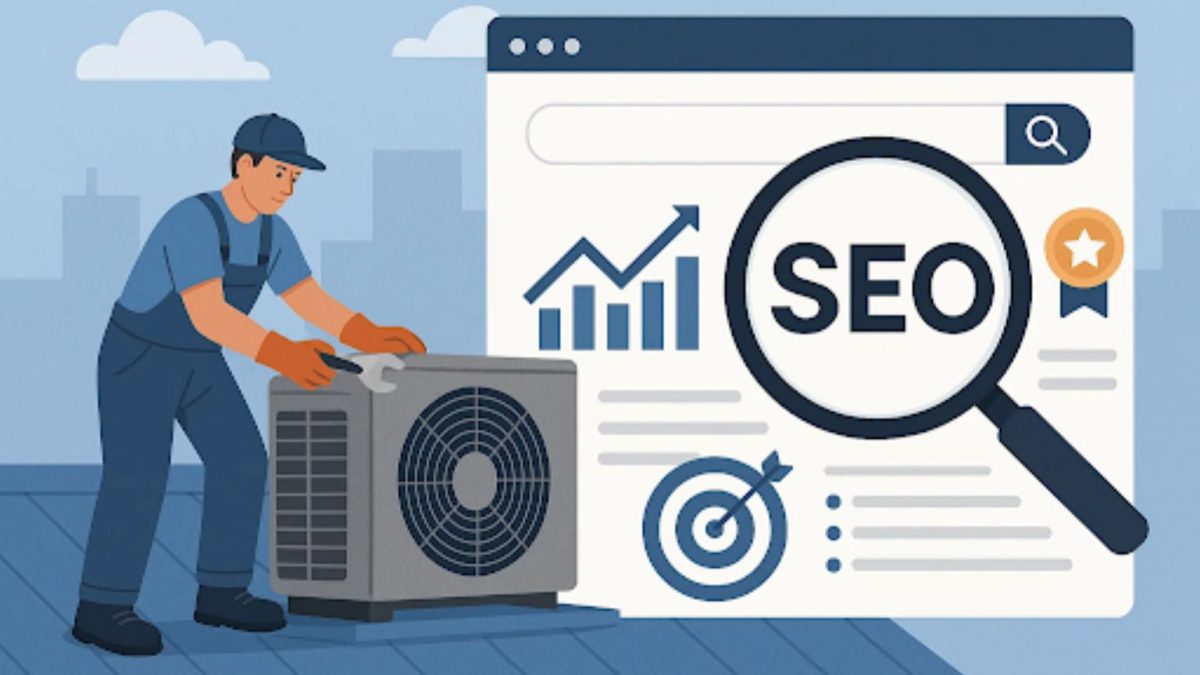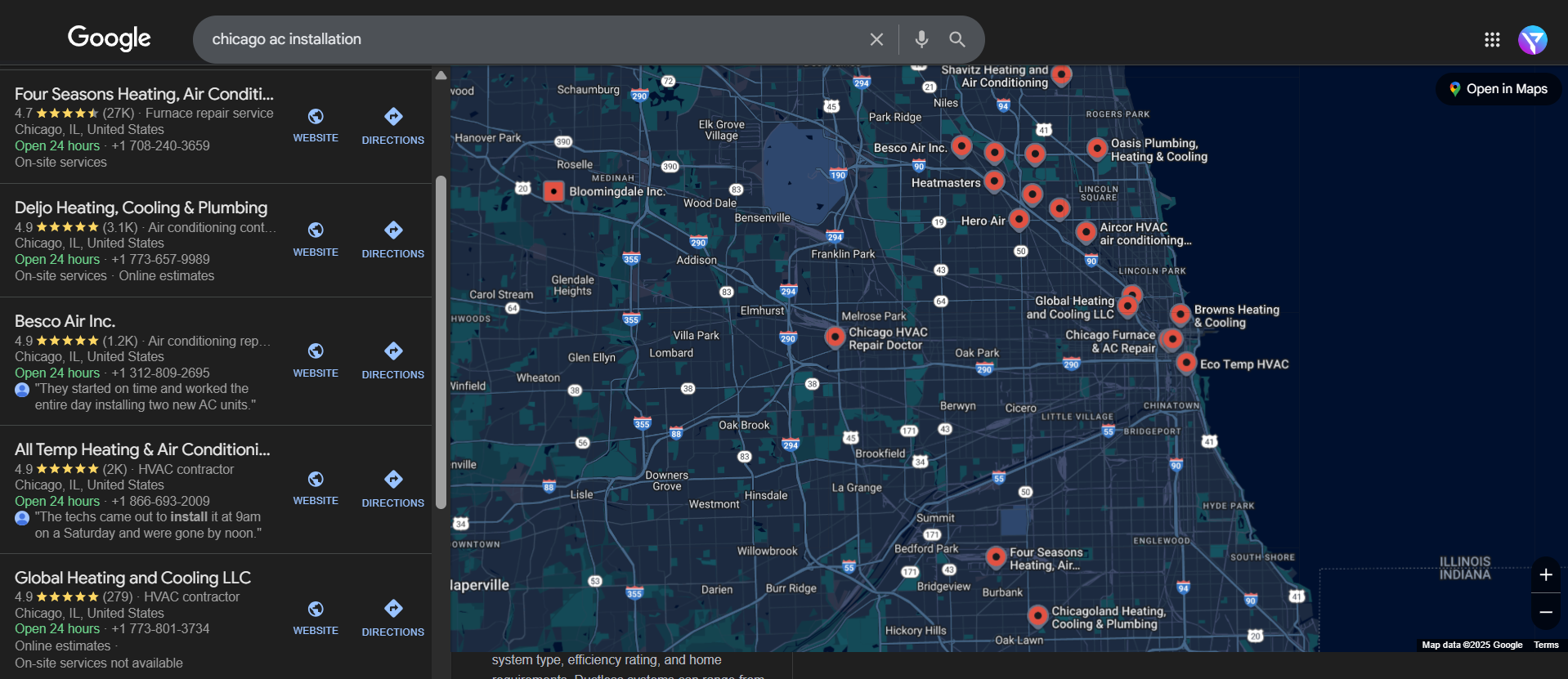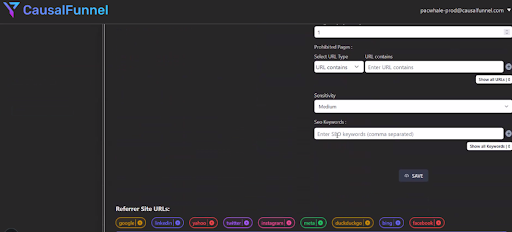
More and more HVAC contractors are looking customers daily, and this is because their competitors have better online visibility.
The moral is that, even though your technical skills are excellent, poor search rankings will hurt your business. This complete HVAC SEO guide shows proven methods to rank higher on Google. We’ll cover strategies that drive quality leads and grow your business in 2025.

HVAC SEO means optimizing your website for search engines so that you rank higher than your competitors. This also means that your potential customers find you before they find your competitors.
When homeowners search “furnace repair near me,” you want your business to appear first. Local SEO for HVAC companies focuses on nearby customers who need your services. Professional local SEO services can help you achieve just that.
Search behavior has changed dramatically in recent years. Well over 90% of people research local businesses online before calling. Mobile searches account for over 60% of all HVAC-related queries. Most customers never scroll past the first page of Google results.
HVAC contractor SEO directly impacts your bottom line profits. Higher rankings mean more visibility. Which means more website visitors and phone calls. The result would be increased appointment bookings and increased revenue.
Effective HVAC SEO starts with understanding what customers actually search for. Your potential clients use specific words when looking for heating services. Professional HVAC SEO keywords research reveals these exact terms and phrases. This knowledge helps you create content that matches customer intent.
Most HVAC contractors guess at keywords instead of using data. This approach wastes time and money on wrong targets. However, the right keyword research approach shows search volume, competition levels, and seasonal trends.
HVAC SEO services include comprehensive keyword analysis for your market area. Professional research identifies high-value terms that drive actual bookings. The goal is finding keywords that convert visitors into paying customers.
Opt for professional SEO Tools that can help you identify untapped keyword opportunities that your competitors have missed and turn them into revenue boosters.
Commercial intent keywords drive the most valuable website traffic. These terms indicate someone ready to hire an HVAC contractor:
Focus on keywords that include location plus service type. Avoid informational terms like “how to fix furnace yourself.” Target searchers who want professional help, not DIY advice.
Note: These keywords are not always in perfect written language, but more in a conversational language.
Local keywords help you dominate your specific service area. Combine your city name with HVAC services for maximum impact. Examples include “Denver furnace repair” and “Chicago AC installation.” Neighborhood targeting works well for larger metropolitan areas.
Create separate pages for each major city you serve. This strategy helps you rank for multiple location-based searches. Each page should focus on one city plus one service.
Using SEO Tools that identify effective keywords that can get your ranking higher up can bring in significantly more organic traffic to your website. These tools offer customization to make your keywords even more helpful.

HVAC demand changes throughout the year based on weather patterns. Summer brings air conditioning repair searches and installation requests. Winter increases furnace repair and heating system replacement queries.
Plan your content calendar around these seasonal patterns. Publish AC content in spring before summer demand peaks. Create heating articles in fall before winter emergencies occur.
Emergency HVAC keywords generate the highest-paying service calls. Customers searching for urgent repairs are usually willing to pay premium rates.
Target terms like “24/7 HVAC repair” and “emergency furnace service.” These keywords convert extremely well despite lower search volumes.
Your website’s on-page elements send important signals to search engines. Proper HVAC website optimization helps Google understand your business better.
Each page should target specific keywords while providing valuable information. Technical optimization improves both rankings and user experience simultaneously.
Title tags are the text that appear as clickable headlines in search results. Keep them under 60 characters for proper display across devices. Include your target keyword near the beginning for maximum impact.
Examples of effective HVAC title tags:
Meta descriptions provide additional context below your title tag. Write compelling descriptions, between Google’s ideal 150-160 character limit, that encourage clicks. Include your phone number so your target audience can easily contact you.
Organize your content using proper header tag hierarchy. There should only be one H1 tag per page containing your main keyword. H2 tags divide content into major sections and topics. H3 tags create subsections under each H2 heading.
This structure helps both readers and search engines understand your content. Proper organization improves user experience and search engine rankings.
Schema markup provides structured data that search engines understand better. LocalBusiness schema helps your HVAC company appear in local results. Include your business name, address, phone number, and service areas.
Review schema displays star ratings directly in search results. Service schema lists your specific HVAC offerings and coverage areas. Proper implementation improves click-through rates and local visibility significantly.
High-quality images improve user engagement and search engine optimization. Name image files descriptively before uploading to your website. Use formats like “HVAC-technician-furnace-repair.jpg” instead of generic file names.
Alt text describes images for search engines and accessibility. Write brief descriptions that include relevant keywords naturally. Compress images to improve page loading speed without quality loss.
Connect related pages through strategic internal linking throughout your website. Link from your homepage to important service pages. Connect city pages to relevant service offerings in those areas.
This strategy distributes page authority and improves search engine crawling. Users find related information more easily through contextual links. Strong internal linking boosts overall website performance in searches.
A majority of HVAC searches happen on mobile devices during emergency situations. Your website must load quickly and function perfectly on smartphones. Google prioritizes mobile-friendly websites in search results rankings.
Fix any issues that prevent proper mobile functionality. Fast loading times reduce bounce rates and improve conversions.
Local search drives most HVAC business leads and revenue opportunities. Homeowners typically hire contractors within a reasonable driving distance. Effective local SEO for HVAC companies captures these high-intent searchers. Your business should appear prominently for location-based service searches.
Professional HVAC SEO company services focus heavily on local optimization. These specialists understand the unique challenges of service-based businesses. They optimize your online presence for maximum local visibility and lead generation.
Your Google Business Profile serves as your primary local listing. Complete every section with accurate and detailed business information. Include real, high-quality photos of your team, trucks, and completed projects, among other relevant images.
Key optimization elements include:
Encourage satisfied customers to leave reviews on your profile. Respond professionally to both positive and negative reviews. This shows that you’re active and care about your customers.
Citations are mentions of your business across all online directories. Therefore, maintain the same information, including Name, Address, and Phone (NAP), everywhere.
Online reviews heavily influence both search rankings and customer decisions. Develop a systematic approach for requesting reviews from customers.
Respond promptly to positive reviews and also to negative reviews with professional and helpful responses.
Create content that speaks directly to your local market area. Write about common HVAC issues specific to your climate. Discuss local regulations and permit requirements for installations.
Local content examples include seasonal maintenance tips and energy efficiency programs. Partner with local utility companies for co-marketing opportunities. Community involvement creates natural content and link building opportunities.
Create dedicated pages for each city or region you serve. Each page should include local keywords and location-specific information. Mention local landmarks, neighborhoods, and community details when relevant.
Include testimonials from customers in each specific area. Show photos of completed projects in those locations. Local relevance improves both rankings and conversion rates significantly.
Technical foundation determines whether your HVAC website can rank successfully. Search engines must crawl, understand, and index your pages effectively.
Poor technical optimization prevents even great content from ranking well. Professional HVAC website optimization addresses these behind-the-scenes ranking factors.
Page speed directly affects search rankings and user experience. Slow websites lose potential customers within seconds of loading. Google considers speed a major ranking factor for mobile searches.
Common speed optimization tactics include:
Test your website speed using Google PageSpeed Insights regularly. Address any issues that slow down your page loading times.
Secure websites display “https” in the address bar instead. SSL certificates encrypt data between visitors and your website. Google requires SSL for websites to rank in search results.
Core Web Vitals measure user experience through loading, interactivity, and visual stability. These metrics directly impact search rankings and customer satisfaction. Monitor these scores through Google Search Console tools.
XML sitemaps are those that help search engines discover and index pages. Submit your sitemap to Google Search Console for faster indexing. Update sitemaps whenever you add new pages or services.
Use clean, descriptive URLs that include relevant keywords naturally. Avoid long, complicated URLs with numbers and random characters. Simple URL structure improves both user experience and rankings.
Many HVAC websites have technical problems that hurt search performance. Broken links create poor user experience and waste search crawl budget.
Regular technical audits identify and fix these issues quickly. Address 404 errors, redirect chains, and missing meta tags. Technical maintenance protects your search rankings and user experience.
Strategic content creation supports your HVAC SEO efforts while building customer trust. Quality information attracts potential customers and encourages social sharing.
Create content that genuinely helps homeowners understand HVAC systems better. Explain complex topics using simple language and clear examples. Educational content builds trust among your target audience and portrays your company to be knowledgeable.
Popular HVAC content topics include:
Focus on problems your customers actually face regularly. Avoid overly technical content that confuses average homeowners.
Plan your content calendar around seasonal HVAC needs and concerns. Publish heating content before cold weather arrives each year. Create air conditioning articles during spring before summer demand.
This timing aligns your content with customer search patterns. Seasonal relevance improves search visibility and user engagement significantly. Early preparation captures searches before peak demand periods.
Video content engages users longer than text-only articles. Create simple videos showing basic maintenance tasks and system explanations. Behind-the-scenes content builds trust and showcases your expertise.
Optimize videos for YouTube search using relevant keywords and descriptions. Embed videos on your website to increase time on page. Video content often appears in Google search results separately.
Every piece of content should guide visitors toward contacting your business. Include clear calls-to-action throughout articles and video descriptions. Offer free estimates or consultations to encourage immediate contact.
Lead magnets like maintenance checklists capture contact information for follow-up. Newsletter signups build ongoing relationships with potential future customers. Strategic conversion optimization turns content readers into paying clients.
Data-driven measurement shows whether your HVAC SEO strategy delivers results. Track metrics that directly connect to business growth and revenue. Regular monitoring helps identify successful tactics and areas needing improvement. Professional HVAC SEO strategy includes comprehensive performance tracking and analysis.
Focus on metrics that indicate real business impact rather than vanity numbers. Important measurements include organic search traffic growth and keyword ranking improvements. Track phone calls generated from search engine visits specifically.
Key performance indicators include:
Connect these metrics to actual booked appointments and completed jobs.
Google Analytics tracks website visitors and their actions accurately. Set up goal tracking for phone calls, contact forms, and appointment requests. Call tracking numbers show which marketing channels drive calls.
Conversion tracking reveals which keywords and pages generate leads. This information helps optimize your budget allocation and content strategy. Accurate data prevents wasting money on ineffective tactics.
Create monthly reports showing progress toward your business goals. Include traffic growth, ranking improvements, and lead generation metrics. Compare performance to previous periods for trend analysis.
Regular reporting identifies successful strategies worth expanding or continuing. Monthly analysis catches problems early before they significantly impact results.
Professional SEO Tools offer a lot more features than basic SEO, they also help with offline conversion tracking for ads to optimize performance based on real data
Calculate return on investment by comparing SEO costs to revenue generated. Track lifetime customer value to understand long-term SEO benefits. Most HVAC customers require multiple services over many years.
Professional SEO typically pays for itself within six months. Improved rankings continue generating leads for years after initial optimization. View SEO as a long-term investment in sustainable business growth.
Emerging search trends create new opportunities for forward-thinking HVAC contractors.
Voice searches naturally use conversational language patterns instead of textual patterns. Optimize for questions like “Who fixes furnaces near me?” rather than “furnace repair.” Smart speakers and mobile assistants drive this search behavior.
Create FAQ content that matches common voice search queries. Focus on local and immediate needs since voice searches often seek quick answers. Conversational content style aligns with voice search trends.
Featured snippets appear above regular search results in highlighted boxes. These prominent placements drive significant traffic to optimized content. Structure content to answer specific questions clearly and concisely.
Use numbered lists, bullet points, and direct question-and-answer formats. Featured snippets often pull from well-organized, scannable content. Target long-tail questions your customers commonly ask technicians.
Research competitors’ SEO strategies to identify opportunities they’re missing. Analyze their keyword targeting, content topics, and local optimization efforts. Look for service areas or topics where competition is weak.
Market gap analysis reveals untapped keyword opportunities and content ideas. Focus your efforts on areas where you can realistically outrank competitors. Strategic positioning beats trying to compete everywhere simultaneously.
This comprehensive guide provides the foundation for successful HVAC SEO in 2025. Your main focus should be on implementing strategies that directly support your business goals.
However, it’s not a one-stop destination. Therefore, consistent effort and professional optimization drive long-term search success and business growth.
Empowering businesses to optimize their conversion funnels with AI-driven insights and automation. Turn traffic into sales with our advanced attribution platform.



